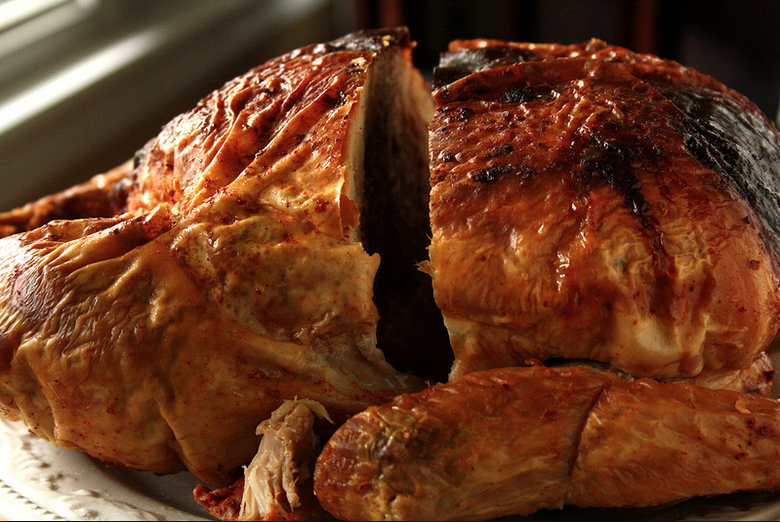
Turducken - the ultimate hybrid holiday dish - consists of a deboned chicken stuffed into a deboned duck, which is in turn stuffed into a deboned turkey.
The word turducken is a combination of turkey, duck, and chicken. The dish is a form of engastration, which is a recipe method in which one animal is stuffed inside the gastric passage of another.
The turkey, duck and chicken are further stuffed in some way - some versions even have a different stuffing for each bird. The result is a fairly solid layered poultry dish, suitable for cooking by braising, roasting, grilling, or barbecuing.


Variations:
A New Orleans surgeon, Dr. Gerald R. LaNasa, was locally known for his use of a scalpel in deboning his three birds of choice sometimes adding pork or veal roasts in the final hen's cavity thus preserving the turducken tradition as a regional holiday favorite of the southern United States. Andouille sausage and Foie Gras were always key ingredients of the LaNasa creations. The results of Dr. LaNasa's work can be found in the modern day mass-produced turducken or turduckhen (another variation adding or substituting a cornish game hen).
Dr. LaNasa's innovation and success with ballontine, Three Bird Roast and turducken began mid century, expanding in the 1960s and seventies long before many of the popular commercial Cajun/Creole chefs of today took the stage. In 1986 Louisiana chef Paul Prudhomme trademarked the Turducken name.
In the United Kingdom, a turducken is a type of ballotine called a "three-bird roast" or a "royal roast". The Pure Meat Company offered a five-bird roast (a goose, a turkey, a chicken, a pheasant, and a pigeon, stuffed with sausage), described as a modern revival of the traditional Yorkshire Christmas pie, in 1989;[3][4] and a three-bird roast (a duck stuffed with chicken stuffed with a pigeon, with sage and apple stuffing) in 1990.[3][4] Multi-bird roasts are widely available.
In his 1807 Almanach des Gourmands, gastronomist Grimod de La Reynière presents his rôti sans pareil ("roast without equal")—a bustard stuffed with a turkey, a goose, a pheasant, a chicken, a duck, a guinea fowl, a teal, a woodcock, a partridge, a plover, a lapwing, a quail, a thrush, a lark, an ortolan bunting and a garden warbler—although he states that, since similar roasts were produced by ancient Romans, the rôti sans pareil was not entirely novel.[4][5][6] The final bird is very small but large enough to just hold an olive; it also suggests that, unlike modern multi-bird roasts, there was no stuffing or other packing placed in between the birds.
Gooducken is a goose stuffed with a duck, which is in turn stuffed with a chicken.[5]
An early form of the recipe was Pandora's cushion, a goose stuffed with a chicken stuffed with a quail.[6]
Another version of the dish is credited to French diplomat and gourmand Charles Maurice de Talleyrand-Périgord. The 1891 newspaper article French Legends Of The Table offers Quail a la Talleyrand:[7]
The following for instance, is Talleyrand's fanciful and somewhat roundabout way of roasting a quail. On a day of "inspiration gourmande" at his hotel in the Rue Saint-Florentin, he composed the following recipe: Take a plump quail, seasoned with truffles, and made tender by having been put into champagne. You put it carefully inside a young Bresse chicken; then sew up the opening, and put dabs of butter all over the chicken. Again, you put the chicken inside a fine Berri turkey, and roast the turkey very carefully before a bright fire. What will be the result? All the juice of the turkey is absorbed by the fowl, and all the juice of the fowl in its turn by the quail. After two hours roasting the fowl, which in reality it composed of three fowls, is ready, and you place the steaming trinity upon a dish of fine porcelain or chiseled silver. Then you pull the chicken out of the turkey, and the quail out of the chicken. The quail? Is it correct to talk of the quail, when this delicious, perfumed dish is indeed too good for any name? You take the quail as you would some sacred relic, and serve it hot, steaming, with its aroma of truffles, after having roasted it to a golden yellow by basting it diligently with the best Gournay butter.
The book Passion India: The Story of the Spanish Princess of Kapurthula[8] (p. 295) features a section that recounts a similar dish in India in the late 1800s: "Invited by Maharajah Ganga Singh to the most extraordinary of dinners, in the palace at Bikaner, when Anita asks her host for the recipe of such a succulent dish, he answers her seriously, "Prepare a whole camel, skinned and cleaned, put a goat inside it, and inside the goat a turkey and inside the turkey a chicken. Stuff the chicken with a grouse and inside that put a quail and finally inside that a sparrow. Then season it all well, place the camel in a hole in the ground and roast it."
Vi Hart's video "Thanksgiving Turduckenen-duckenen" shows her making what she calls a "turduckenailailenailailduckenailailenailail." [9] This is a binary treevariant of turduckenen, in which she places two quail eggs inside each of two hens inside each of two ducks in a turkey.
In popular culture[edit][]
American football commentator John Madden mentioned turducken during a National Football League broadcast. While announcing for CBS Sportshe displayed a turducken and began carving it. He promoted it again on Fox Sports by awarding a turducken to players on the winning team of the Thanksgiving Bowl. On the November 9, 2008 broadcast of NBC Sunday Night Football, Madden responded to a fan's sign reading "JOHN MADDEN, BRING BACK TURDUCKEN" by calling his fixation with turducken "a thing of the past," stating that he would return to a traditional turkey for subsequent Thanksgivings.


